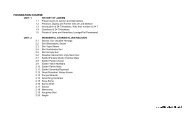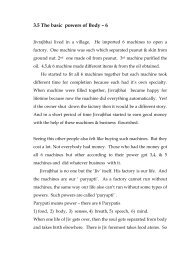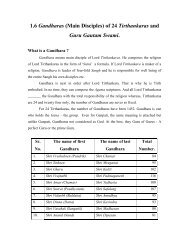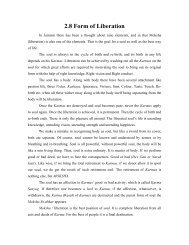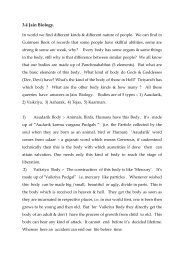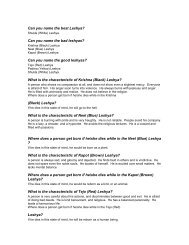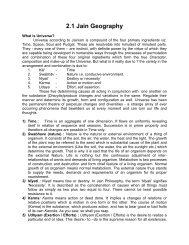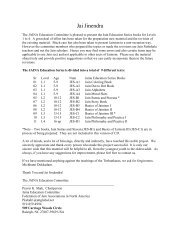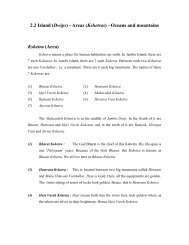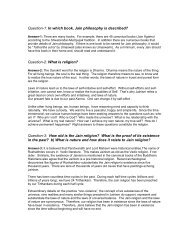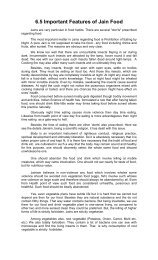Paryushan Parva - Jainism, Jain Religion - colleges
Paryushan Parva - Jainism, Jain Religion - colleges
Paryushan Parva - Jainism, Jain Religion - colleges
Create successful ePaper yourself
Turn your PDF publications into a flip-book with our unique Google optimized e-Paper software.
Sämäyik in English with Meaning<br />
State of Equanimity<br />
of our karma. Its white-wool string-group is 8 fingers tall, to remind us that we are entrapped in the<br />
worldly existence (journey of misery) because of the eight main karma. Charavalo and Muhapatti,<br />
both constantly remind the aspirant that he/she is in Sämäyik, he/she has to exercise equanimity<br />
during the Sämäyik. Woman’s Charavalä has square wooden stick symbolyzing the entrapment in<br />
the four destinies, and man’s Charavalä has round wooden stick signifying freedom from the cycles<br />
of four destinies and attainment of Moksha.<br />
Katäsanu: It is also known as Äsan. Katäsanu means the piece of mat on which one sits and<br />
experiences discomfort (kasht). It should be of white wool. Wool indirectly helps in abandoning the<br />
bad elements, and attracts the good elements. It insulates the body from<br />
loosing the energy that is generated due to the practice of Sämäyik. It protects<br />
subtle mobile living beings underneath. White color promotes peace and<br />
enhances the spiritual environment.<br />
Muhapatti: It is a small piece of white cloth folded in a particular way, used in front of the mouth<br />
about 2 to 3 inches away while reciting Sämäyik Sutras. Because of Muhapatti,<br />
one becomes careful about what he/she speaks, and stops him/her from saying<br />
lies, and making provocative and non-beneficiary speech to others. One<br />
controls his/her speech, and speaks only when it is necessary. Uncontrollable<br />
spits are stopped by the muhapatti from falling on the instruments of knowledge<br />
such as books. Insentient and worm air that is coming out of the mouth is also stopped from mixing<br />
with sentient and cold air of the outside, thus becomes the act of non-violence. By use of Muhapatti,<br />
one becomes humble and courteous. Muhapatti is about 10 to 12-inch square white cloth piece,<br />
folded in half, then folded about one inch from the closed side, and then it is folded laterally. This<br />
way it has three open sides and one closed side, and it symbolizes that living beings attain Moksha<br />
through only one destiny 9 - human beings, and not from other three destinies.<br />
Religious books: To study for 48 minutes during Sämäyik.<br />
Sthäpanächärya: The preceptor’s seat that is installed when the right guru 10 is not present by putting<br />
a religious book that contains Navakär Mahämantra 11 on a Säpada (book stand) with<br />
9 There are a total of four destinies: 1. Hellish beings (näraki), 2. Tiryancha (all living beings other than Heavenly<br />
beings, human beings and hellish beings), 3. Human beings (manushya), and 4. Heavenly beings (dev)<br />
10 Guru is who: 1. is at least practicing five mahävratas (great vows), five samitis (carefulness) and three Guptis<br />
(restraints); has taken Dikshä (initiation) per either Digambar or Svetämbar tradition, 2. who practices Samatä<br />
(equanimity; treats the favorable and non-favorable situations indifferently.), 3. who preaches the major path of<br />
liberation shown by our Tirthankars, 4. emphasizes on the self-efforts and self-initiatives, 5. who firmly believes in the<br />
anekäntväd, and 6. has given up pleasures of five senses, has no worldly attachments like assets, family, bank balance,<br />
house, car and similar things and has won over internal enemies like anger, ego, deceit and greed.<br />
11 Mahä means great and mantra means selection, combination and recitation of the words that purifies body, mind and<br />
speech. The Navakär Mahämantra is the most fundamental mantra in <strong><strong>Jain</strong>ism</strong> and can be recited at any time of the day.<br />
While reciting the Mahämantra, the aspirant bows down with respect to Arihants, Siddhäs, Ächäryäs, Upädhyäyas,<br />
Sädhus, and Sädhvis. The Mahämantra enables us to worship the virtues of all the supreme spiritual people instead of<br />
just worshipping one particular person. For this reason, the Navakär Mahämantra does not mention the names of any<br />
Tirthankaras, Siddhäs, Ächäryäs, Upädhyäyas, Sädhus, or Sädhvis. At the time of recitation, we remember their virtues<br />
and try to emulate them. In this Mantra we bow down to these five great souls, and therefore, it is also called Namaskär<br />
or Namokär Mahämantra. The Navakär Mahämantra contains the essence of <strong><strong>Jain</strong>ism</strong>. It points out that if we want to<br />
be truly liberated, we have to give up worldly life (samsär). The first stage of renunciation is to become a monk (Sädhu)<br />
or nun (sädhvi). While progressing on a spiritual path, some may be designated as Upädhyäya or Ächärya. The ultimate<br />
aim is to attain omniscience, becoming an Arihant, which leads us to liberation.<br />
6



